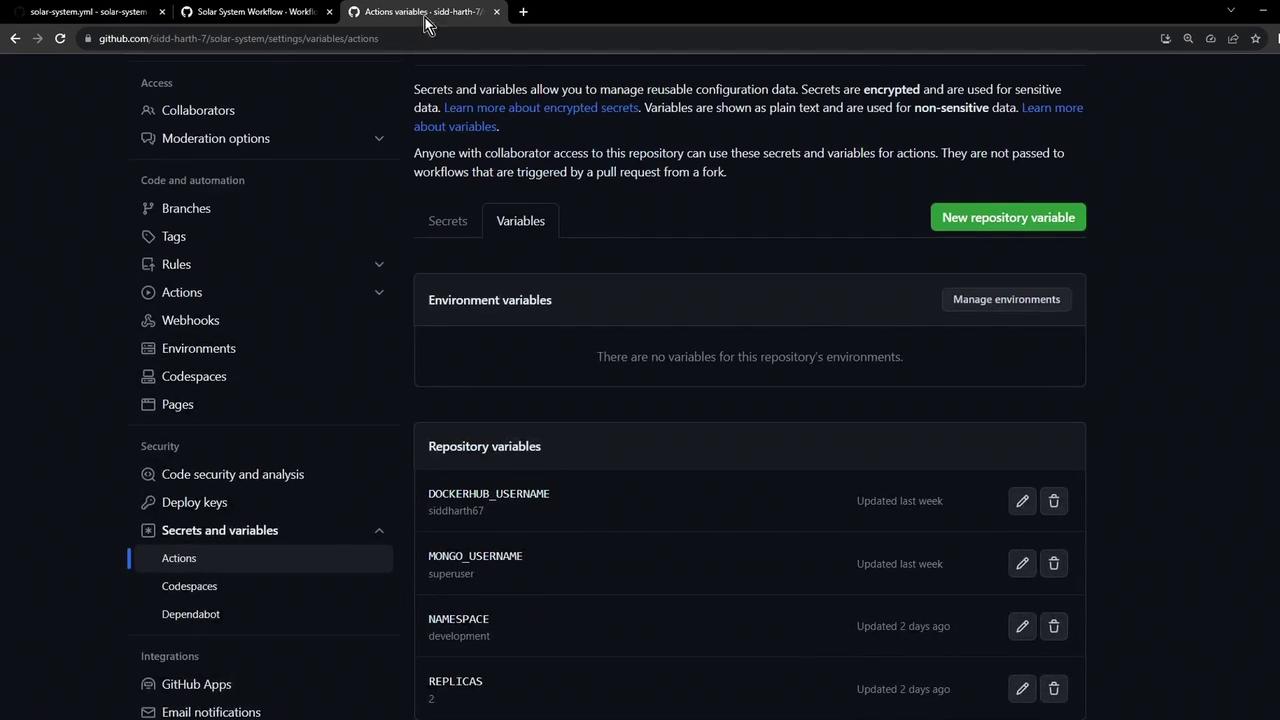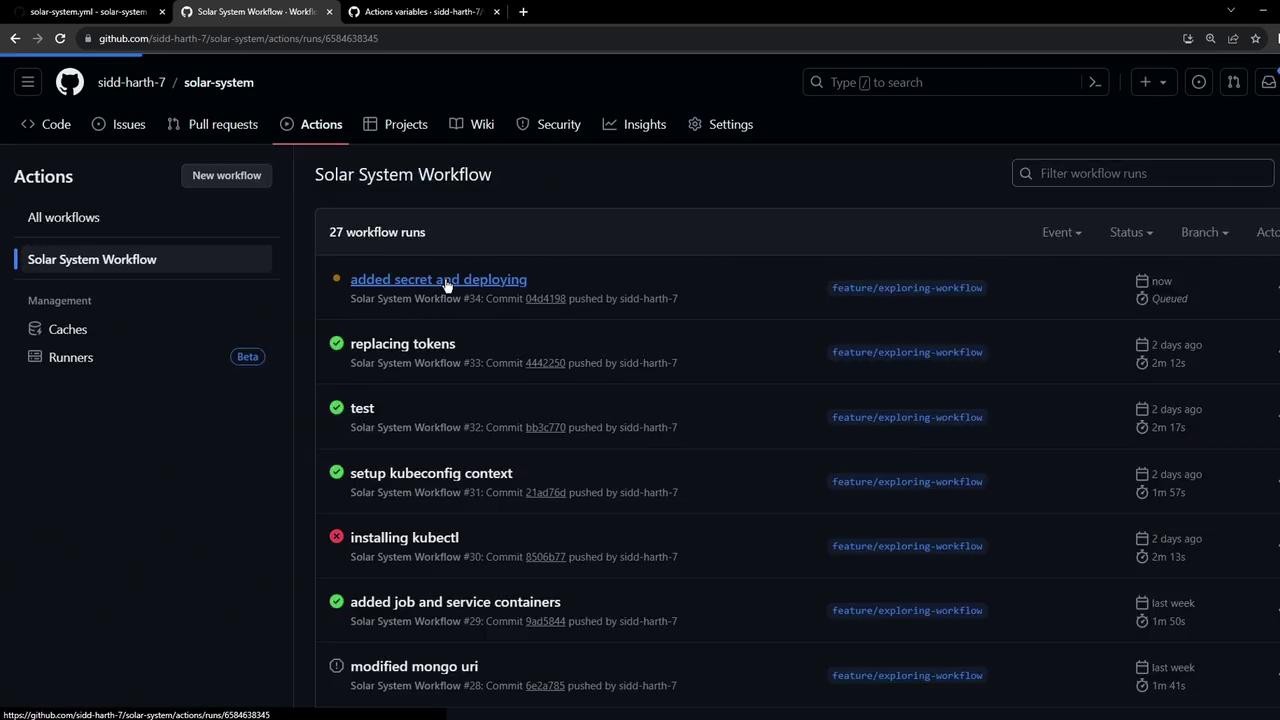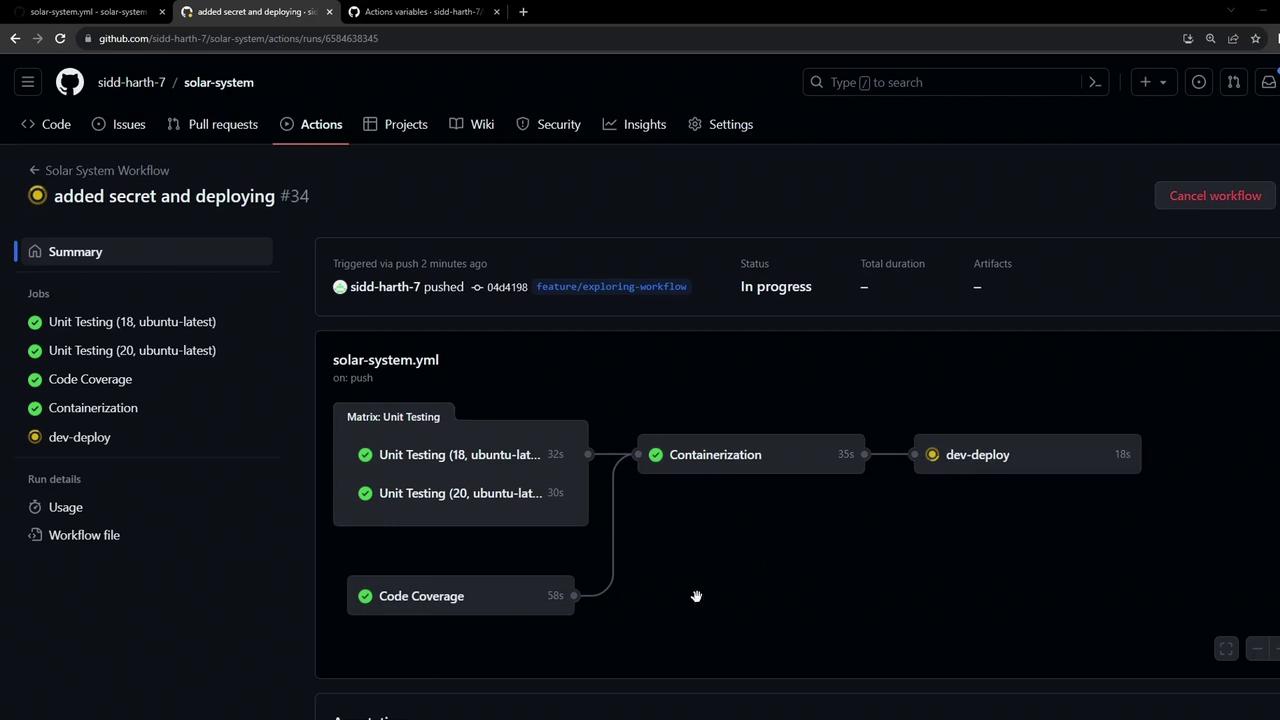GitHub Actions Certification
Continuous Deployment with GitHub Actions
Workflow Create Secret and Deploy to Kubernetes Dev Environment
In this guide, you’ll learn how to deploy your application to a Kubernetes development environment using GitHub Actions. We’ll assume your Kubernetes manifests already contain the correct values, then show you how to add a dev-deploy job that replaces tokens, creates a MongoDB secret, and applies your manifests.
1. Update the GitHub Actions Workflow
Open .github/workflows/main.yml and add the dev-deploy job:
name: Solar System Workflow
on:
workflow_dispatch:
push:
branches:
- main
- 'feature/*'
env:
MONGO_URI: 'mongodb+srv://supercluster.d83jj.mongodb.net/superData'
MONGO_USERNAME: ${{ vars.MONGO_USERNAME }}
MONGO_PASSWORD: ${{ secrets.MONGO_PASSWORD }}
jobs:
unit-testing:
# …
code-coverage:
# …
docker:
# …
dev-deploy:
runs-on: ubuntu-latest
needs: docker
steps:
- name: Checkout repository
uses: actions/checkout@v3
- name: Replace tokens in manifest files
uses: cschleiden/replace-tokens@v1
with:
tokenPrefix: '_'
tokenSuffix: '_'
files: kubernetes/development/*.yaml
env:
NAMESPACE: ${{ vars.NAMESPACE }}
REPLICAS: ${{ vars.REPLICAS }}
IMAGE: ${{ vars.DOCKERHUB_USERNAME }}/solar-system:${{ github.sha }}
INGRESS_IP: ${{ env.INGRESS_IP }}
- name: Verify updated manifests
run: |
cat kubernetes/development/*.yaml
- name: Create MongoDB Secret
run: |
kubectl -n ${{ vars.NAMESPACE }} create secret generic mongo-db-creds \
--from-literal=MONGO_URI=${{ env.MONGO_URI }} \
--from-literal=MONGO_USERNAME=${{ env.MONGO_USERNAME }} \
--from-literal=MONGO_PASSWORD=${{ secrets.MONGO_PASSWORD }} \
--save-config \
--dry-run=client \
-o yaml | kubectl apply -f -
- name: Deploy to Dev Environment
run: |
kubectl apply -f kubernetes/development
2. Kubernetes Deployment Manifest
Ensure your deployment.yaml in kubernetes/development/ references the secret for environment variables:
apiVersion: apps/v1
kind: Deployment
metadata:
name: solar-system
namespace: _NAMESPACE_
labels:
app: solar-system
spec:
replicas: _REPLICAS_
selector:
matchLabels:
app: solar-system
template:
metadata:
labels:
app: solar-system
spec:
containers:
- name: solar-system
image: _IMAGE_
imagePullPolicy: Always
ports:
- containerPort: 3000
envFrom:
- secretRef:
name: mongo-db-creds
3. Repository Variables and Secrets
Configure the following under Settings > Secrets and variables in your GitHub repository.

| Variable / Secret | Type | Description |
|---|---|---|
MONGO_URI | Environment Variable | MongoDB connection string. |
MONGO_USERNAME | Repository Variable | Username for MongoDB. |
MONGO_PASSWORD | Encrypted Secret | Password for MongoDB. |
NAMESPACE | Repository Variable | Kubernetes namespace (e.g., development). |
REPLICAS | Repository Variable | Number of pod replicas (e.g., 2). |
DOCKERHUB_USERNAME | Repository Variable | Docker Hub account name. |
4. Running the Workflow
Push your changes to main or any feature/* branch. Then, monitor the pipeline in the Actions tab of your repository.

Note
The dev-deploy job runs after the docker job (and its dependencies: unit-testing and code-coverage). It checks out the repo, replaces tokens, creates the MongoDB secret, and applies the Kubernetes manifests.

5. Verifying in Kubernetes
Once the workflow succeeds, confirm the resources:
kubectl -n development get secrets
kubectl -n development get all
You should see:
mongo-db-credssecret- Deployment and Pods for
solar-system - Service and Ingress resources
6. Accessing the Application
Retrieve and open the ingress endpoint:
kubectl -n development get ingress
Open the HOSTNAME in your browser.
Warning
If you encounter a self-signed certificate warning, safely accept it to proceed to the application.
This lesson covers creating a Kubernetes secret and deploying to a development cluster via GitHub Actions. Integration testing for this deployment will be addressed in an upcoming article.
Links and References
- [GitHub Actions Documentation][GitHub Actions]
- [GitHub Secrets and Variables][GitHub Secrets and Variables docs]
- [Kubernetes Secrets][Kubernetes Secrets]
- [Kubernetes Ingress][Ingress docs]
Watch Video
Watch video content